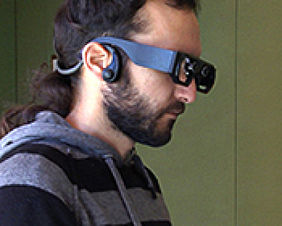Our brain creates representation of ourselves and of the ambient around us. The representation of ourselves is made through proprioceptors, "sensors" that inform the brain on the position of our limbs, our head, our body. The representation of the ambient takes place mostly through our eyes. That is not the case in other species, like bats that use sounds (ultrasound) to create a representation of the ambient.
Hence, we shouldn't be surprised if we hear that somebody is trying to use sound to provide hints on the ambient to people that have lost (or never had) vision capability.
Indeed, this is what a doctoral student, Pablo Revuelta, at the University Carlos III of Madrid has created in his doctoral theses.
The devices looks like a (almost) normal pair of glasses that the person with impaired vision would wear. The glasses embed two video cameras connected to a pocket computer for the processing of the images. The processing creates a 3D space with objects that are then converted into sounds identifying their encumbrance and their distance from the wearer.
These sounds are "delivered" by two loudspeakers directly at the head of the person. The study has focussed on the creation of a sound system that can be easily learnt by the person. A louder sound on the right signals that the object is closer to the right of the person, the loudness for a sound that is "centred" indicated the relative distance from the object and so on.
This is clearly a code that needs to be learned by each individual. The expectation of the researcher is that as times goes by this sound system will become "embedded" in the representation process of the brain so that the internal visualisation becomes seamless. This is not a hill founded expectation. Our brain demonstrates over and over its capability to "take over" in a seamless way processes that at the beginning seems complicated, be it riding a bicycle or reading a text. It is hard to learn but once you have done it that's it.
It is interesting to notice how we can exploit ICT and the capability of our brain. It is also interesting to note that an innovation to hit the market has to be "economically" affordable. And this is the case here. The all system is designed to have a pricing point around 250€. It is this attention to the pricing point that distinguishes a research endeavour from an innovation one.







